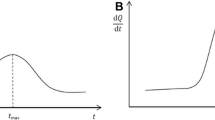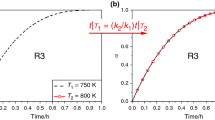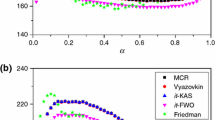Abstract
Computer modelling calculations will be presented which verify the fact that, if a single reaction follows either Arrhenius or transition state kinetic theory over its entire extent, then the maximum rate of reaction data obeys the modified Kissinger equation, irrespective of the applicable kinetic model. The magnitude of the Kissinger parameter correction term is dependent on the model, ranging from about 0.4% for nth order and random nucleation, Avrami-Erofeev models to 17% for three dimensional diffusion controlled reactions. The consequences of selecting the incorrent kinetic model in interpreting experimental thermoanalytical data will be examined, thereby giving a rational explanation for the wide range of published kinetic parameters for a number of solid state decompositions.
Zusammenfassung
Computer-Modellberechnungen werden dargelegt, die die Tatsache bestätigen, daß die maximale Reaktionsgeschwindigkeit unabhängig vom angewandten Modell von der modifizierten Kissinger-Gleichung beschrieben wird, wenn eine einzelne Reaktion über den gesamten Verlauf hinweg entweder der kinetischen Arrhenius- oder der Übergangszustands-Theorie folgt. Die Größe der Kissinger-Parameter hängt vom Modell ab und liegt zwischen 0,4% für Avrami-Erofeev-Modelle mitn-ter Ordnung und ungeordneter Kristallkeimbildung und 17% für dreidimensionale diffusionskontrollierte Reaktionen. Die bei Wahl eines falschen kinetische Modells für die Interpretierung thermoanalytischer Daten eintretenden Folgen werden untersucht, wobei eine vernünftige Erklärung für die große Streuung von publizierten kinetischen Parametern einer Anzahl von Festkörperzersetzungsreaktionen gegeben wird.
Резюме
Представлены компью терные модельные рас четы, подтверждающие, что е сли единственная реакци я полностью подминае тся уравнению Аррениуса или теории переходно го кинетического состо яния, тогда максималь ная скорость реакции подчиняется видоизмененному уравнению Киссиндже ра, независимо от прим еняемой кинетической модели. Значение параметра Киссинджера коррекц ионного множителя за висит от взятой модели и измен яется от 0,4% длаn-порядка реакции и мо дели произвольного образования центров кристаллизации моде ли Аврами-Ерофеева до 17% — для модели трехразме рных диффузионно-контрол ируемых реакций. Исследованы последствия выбора н еправильной кинетической модели при интерпретации экспериментальных т ермоаналитических д анных, давая к этому рациональное о бъяснение широкому интервалу п убликуемых кинетиче ских параметров ряда твер дотельных реакций разложения.
Similar content being viewed by others
Abbreviations
- α :
-
extent of reaction (dimensionless)
- dα/dt:
-
rate of reaction (min−1)
- f (α):
-
general expression for kinetic model
- F(α) :
-
general expression for the integral of the inverse (fα) function
- T :
-
absolute temperature (K)
- E :
-
energy of activation (kJ·mol−1)
- A :
-
pre-exponential factor (K−m·min−1)
- m :
-
exponent of weak temperature term in rate equation (1)
- R :
-
universal gas constant (8.31434 kJ·mol−1 K−1)
- β :
-
heating rate (deg. min−1 or K·min−1)
- p m(E/RT):
-
general function including the exponential temperature integral
References
J. P. Elder and M. B. Harris, Fuel, 63 (1984) 262.
J. P. Elder and V. B. Reddy, Proc. Eastern Oil Shale Symposium, Lexington, KY, November, 1983, p. 255.
H. E. Kissinger, J. Res. Nat. Bur. Stds., 57 (1956) 217.
T. Ozawa, J. Thermal Anal., 2 (1970) 301.
J. P. Elder, in Analytical Calorimetry, Vol. 5 (Eds. P. S. Gill and J. F. Johnson) Plenum Press, New York, 1984, p. 269.
J. P. Elder, J. Thermal Anal., 29 (1984) 1327.
C. D. Doyle, J. App. Pol. Sci., 6 (24), (1962) 639.
J. Blazejowski, Thermochim. Acta, 48 (1981) 125.
W. E. Brown, D. Dollimore and A. K. Galwey, in Comprehensive Chemical Kinetics, Vol. 22 (Eds. C. H. Bamford and C. F. H. Tipper), Elsevier, New York, 1980, Chap. 3, p. 90.
Ibid, p. 74.
H. L. Friedman, J. Polymer Sci., 6C (1965) 183.
J. Zsakó and H. E. Arz, J. Thermal Anal., 6 (1974) 651.
J. Blazejowski, J. Szychlinski and K. Windorpska, Thermochim. Acta, 46 (1981) 147.
J. Sestak and G. Berggren, Thermochim. Acta, 3 (1971) 1.
Author information
Authors and Affiliations
Additional information
This work was conducted as a part of the Kentucky Energy Resource Utilization Program supported by the Commonwealth of Kentucky, Kentucky Energy Cabinet.
Rights and permissions
About this article
Cite this article
Elder, J.P. The general applicability of the Kissinger equation in thermal analysis. Journal of Thermal Analysis 30, 657–669 (1985). https://doi.org/10.1007/BF01913612
Received:
Revised:
Issue Date:
DOI: https://doi.org/10.1007/BF01913612




